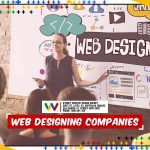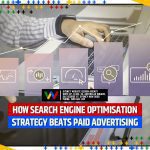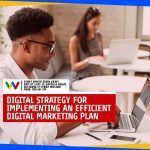Web Design Best Practices
Design is one of the most important aspects of any website. It can make or break a website when it comes to traffic and sales. Although there are many design principles, following some best practices will help ensure that your website stands out from the rest.
Investing in a good website design is similar to investing in yourself. The more you study, take care of your looks, and your body, the more pleasant and attractive and impressive you’ll be to people. Incorporating great design and valuable content on your professional website is your stepping stone to a robust digital presence in your industry.
Introduction
Creating a website is an important task for any business. Your website is the face of your company, and it’s often the first impression potential customers will have of you. That’s why it’s essential to create a website that looks great and is easy to use. To achieve that, you need to follow some basic web design best practices.
The definition of a good website or web design project can vary from one brand to another. Nonetheless, working with a seasoned web designer makes the design process easier.
In this comprehensive guide to web hosting, we’ll take a look at some of the best practices for designing an exceptional website. We’ll discuss how to create a purposeful layout, how to use persuasive content, and how to encourage user engagement. We’ll also offer tips for collaborating with your web designer for the best possible results.
Table of Contents
- Why is Web Design Important for Small Businesses
- Creating an Ecommerce Website that Stands Out from the Competition
- Basics of Web Design: What To Include on Your Website
- Creating an Online Presence for Your Business with Social Media
- Web Design Project Common Denominators
- Tips for Optimising Your Website for Search Engines
- Our Web Design and Development Process
- Web Design Frequently Asked Questions
Why is Web Design Important for Small Businesses

Web design is critical for small businesses because it can be the difference between a website that converts visitors into customers, and a website that doesn’t. A well-designed website will help instil trust in your brand and make it easier for visitors to find the information they need. On the other hand, a poorly designed website can damage your brand and turn visitors away.
As a startup brand, you will to put your best foot forward to gain the attention and confidence of your audiences. You will need to invest effort into your brand – the way your website looks, your branding, the content on the web pages that your website will have to gain recognition. Business growth only happens when you invest effort in building and marketing your brand.
Having a well-thought website design is critical for your small business. On top of chasing your target market, you need to attract these audiences. With a stunning and highly optimised user interface design, you’ll be able to gain audiences. Together with a good content management system, a good product or service to other and well develop websites, your business can grow tremendously.
Creating an ECommerce Website that Stands Out from the Competition

You need to be unique, but at the same time relevant to what your target market needs. Most importantly, you must be able to offer products or services that live up to what you market and advertise. You must walk the talk. Although the initial look of your website can capture and keep the attention of your target market, quality products and services makes them come back and become loyal customers.
Imagine you are an HR personal meeting an interview. You meet a person dressed to impress with an equally spectacular resume with him. You sit down and talk, only to realise that what you see and read did not translate to the person you are talking too. You lose interest.
The same is true with web design. Having the best web designers work on your website and design websites with content to boast does not guarantee success. So, even if web design is invaluable for your small business website, it is still important to deliver quality service and products to the leads and conversions captured on your website.
Basics of Web Design: What To Include on Your Website

Clean and Responsive Layouts
The layout of your website should be easy to navigate, with clear and concise menus. Make sure the font size is large enough to be easily read, and use standard web fonts so that all users will see the same text regardless of their device or browser, also known as responsive design.
Responsive design is the practice of making sure your website looks good on screen sizes of all devices. With more and more people using mobile devices to access the internet, it’s indispensable to make sure your website is responsive. This means your website should adjust to fit the screen size of any device.
Whitespace
Whitespace is the space on a webpage. It’s essential to use whitespace in your web design because it makes your content easier to read and digest. Too much content on a web page can be overwhelming for visitors, but if you use whitespace wisely, you can guide visitors’ eyes to the most significant parts of your page.
Your website should be visually appealing without being cluttered or overwhelming. Use clean lines and minimalist design elements to create a polished look.
Colours, Fonts, and High-Quality Images
The colours you use on your website should be in line with your brand. If you have a colourful brand, then you can use more colour in your web design. However, if your brand is more subdued, then you’ll want to use colours that are softer and easier on the eyes. In general, it’s best to avoid using more than three colours on your website.
The fonts you use on your website should be easy to read. This is especially important if you have a lot of text on your website. Some fonts are more difficult to read than others, so it’s critical to choose wisely. Additionally, you should make sure the font size is large enough to be easily readable.
Good quality images can really enhance the look of your website, but make sure they are properly sized and formatted for the web. Avoid using low-resolution graphics or taking images from other websites without permission – this can lead to legal troubles as well as a poor user experience.
Web design projects takes time to be able to deliver an online store or professional website suited for the business goals and unique needs of brands. There is no website alike, and different target markets have different preferences when it comes to web design. This clear website objectives are necessary to deliver targeted results.
Call to Actions
A call to action (CTA) is a statement or button that encourages website visitors to take a specific action. CTAs should be used sparingly on your website, as too many can be overwhelming. However, they can be effective in driving conversions, so it’s essential to include them in your web design. Make sure your CTAs are clear and concise, and that they stand out from the rest of your content.
Everything from the wording on your buttons to the spacing between paragraphs can affect how users interact with your website. Make sure all your text is properly formatted and easy to read, and use consistent styling throughout the site.
Always test your website on different devices and browsers before going live. Make sure all links work properly and that all content is displayed correctly in all configurations. You may also want to run some user testing to get feedback on how well the design works in practice.
Creating an Online Presence for Your Business with Social Media

Social media platforms like Facebook, Twitter, and Instagram provide businesses with a way to connect with potential and current customers. These platforms can be used to share information about your products or services, as well as to build relationships with customers.
Creating social media accounts for your business is relatively simple and straightforward. However, it’s important to keep in mind that these platforms require regular maintenance and engagement to be effective. Let’s take a look at some tips for using social media effectively for your small business:
Sharing Useful and Relevant Information About Your Business
One of the best ways to use social media for your business is to share helpful and relevant information with your followers. This could be anything from blog posts and articles to tips and advice. Sharing this type of content will show your followers that you’re an expert in your field, and it will also help to build trust.
Connecting with Customers
Another great way to use social media is to connect with customers and build relationships. You can do this by responding to comments and questions, as well as by sharing customer stories and testimonials. When you connect with customers on a personal level, they’re more likely to become loyal fans of your business.
Promoting Products and Services
Of course, you can also use social media to promote your products or services. This could be done through simple posts about new products or services, as well as through more elaborate campaigns and contests. Just be certain not to overdo it, as too much promotion can be off-putting for potential customers.
But where does web design comes into the picture? Web designers in Sydney will help you to create branding that lingers not only in your website design but as well as other channels that represent your brand.
This is one of the most important aspects of your web structure. Having cohesive branding and visual appeal is one of the keys to create your brand’s identity and make it relatable to your audience. With a web design service team to back you up, you can easily achieve this.
By following these tips, you’ll be able to use social media effectively to reach more customers and grow your small business.
Common Denominators for Successful Website Designs

What do the best website designs have in common? While there is no one-size-fits-all answer to this question, there are certain design elements and practices that tend to produce consistently exceptional results. Here are just a few of the things that the best website designs typically have in common:
Simplicity
While the look of your website is crucial, most visitors are not there to assess how slick the design is. They wish to accomplish some task or discover some information.
As a result, needless design features (those that serve no practical function) will only confuse and obstruct visitors in completing what they want to do.
Visual Hierarchy
The visual hierarchy of a website is the process of arranging and structuring website components in such a manner that visitors are drawn to the most essential parts first.
Remember that the objective of optimising a responsive web design for usability and UX is to get people to perform a particular action in a natural and compelling way. To pique people’s interest, you may reposition, colour, or scale your site’s components.
Ease of Navigation
Your website’s navigation system is essentially its road map. It needs to be well-organised and easy to understand so that visitors can find their way around with minimal effort.
A good navigation system will:
- Be intuitive and easy to use
- Be consistent across all pages
- Use clear and descriptive labels
- Organise information logically
In general, it is best to keep the navigation as simple as possible. If your website has a lot of content, you may consider using drop-down menus or other types of advanced navigational features to help people find what they are looking for quickly and easily.
Consistency
The colour palette, font style, and tone of your writing should be the same on all of your site’s pages. Backgrounds, colour schemes, typefaces, and even the tone of your writing have a beneficial impact on usability and UX if they are consistent across all of your site’s pages.
That isn’t to suggest that your website’s pages should all be structured the same way. Instead, create a variety of layouts for various sorts of pages (landing sites, educational pages, and so on). You’ll make it simpler for visitors to figure out what sort of information they’re likely to find on each page by using these designs consistently.
Accessibility
The goal of web accessibility is to create a website that anyone can use, regardless of their physical or mental abilities, as well as those who have impairments in their browsing experience. It’s your responsibility as a website designer to consider these users when creating your UX strategy.
You can also achieve a similar goal by focusing on just one of them. For example, encouraging visitors to interact with your site’s content through the actions they take is an excellent method to increase interaction.
Conventional
Balancing originality with expectations is a difficult aspect of web design. We’ve all become experienced internet users, and there are certain norms that have emerged over time.
Your website’s visitors will likely have some preconceived notions about how your site ought to look and work. They’ll be looking for specific elements in specific places. If you deviate too far from these conventions, you risk confusing or frustrating your visitors.
On the other hand, if your website looks and feels exactly like every other site out there, it risks being forgettable. There needs to be a happy medium where your website is still recognisable as belonging to its niche, while also providing something new and different that sets it apart from the competition.
Credibility
Sticking to web standards enhances your site’s credibility. In other words, it raises the amount of trust that your site conveys. Credibility is also important when you’re trying to create a website that provides the best user experience possible.
Being clear and honest about the product or service you’re offering is one of the most effective methods to enhance your credibility. Don’t make visitors sift through dozens of pages searching for what you do. Be upfront with your visitor on your homepage, and devote some real estate to describing the benefit behind what you do.
Tips for Optimising Your Website for Search Engines

Choose the right keywords
The first step in optimising your website for search engines is to choose the appropriate keywords. These are the terms that potential customers are likely to use when searching for businesses like yours. To select the appropriate keywords, think about what products or services you offer, and what words or phrases people would use to find them. You can use keyword research tools like Google AdWords Keyword Planner and Moz Keyword Explorer to find relevant keywords.
Use keywords throughout your site
Once you’ve selected the appropriate keywords, it’s important to use them throughout your website. This includes using them in your website’s title, header tags, meta tags, and content. Using keywords strategically can help search engines understand what your website is about, and index it accordingly.
Optimise your website’s structure
The structure of your website is also critical for optimisation purposes. Search engines like websites that are well-organised and easy to navigate. As such, you should make sure your website has a clear hierarchy, and use descriptive titles and URLs. You should also use breadcrumbs to help users navigate your website, and include a sitemap to help search engines index your website’s pages.
Improve your website’s loading speed
Another critical factor for optimisation is website loading speed. Search engines like websites that load quickly, as this provides a better user experience. To improve your website’s loading speed, you should compress images, minify CSS and JavaScript files, and use a content delivery network (CDN).
Create high-quality content
In addition to using the appropriate keywords, it’s also important to create high-quality content. This means creating informative and keyword-rich blog posts, articles, and product descriptions. Your content should be well written and relevant to your target audience. It should also be updated regularly to ensure that it remains fresh and up-to-date.
By following these tips, you can optimise your website for search engines and improve your site architecture chances of ranking high in search results. This, in turn, can help you attract more traffic to your website and generate more leads and sales.
Our Web Design and Development Process
The web design and development process is a comprehensive journey aimed at creating a visually appealing, functional, and conversion-oriented website. Let’s delve into each phase of this process while incorporating the provided keywords.
Discovery Phase
At the start of your website project, our team of skilled web designers and developers kick off a thorough exploration process. We dive deep into grasping your unique business goals, target audience demographics, and the competitive landscape you’re in.Through detailed research and analysis, we discover valuable insights that shape the rest of the web design journey.
Using our expertise and industry knowledge, we spot opportunities to create a website that not just meets but surpasses your expectations.
Working closely with your digital marketing manager ensures we’re in sync with your broader marketing strategies and goals.
Planning Phase
In the planning phase, we turn the insights from the discovery phase into practical strategies. Our team works with your stakeholders to outline your website’s structure, content, and features.
We craft detailed wireframes and sitemaps as blueprints for user experience, making sure visitors navigate easily. With clear project milestones and timelines, we set a roadmap for your web design project.
This teamwork promotes transparency, guaranteeing your website aligns with your brand and marketing goals.
Design and Development Phase
With a solid plan in place, our team of talented designers and developers gets to work to bring your vision to life. We use the latest tech and top web development practices to craft a fully integrated custom site that mirrors your brand essence.
Whether it’s an online store or a corporate site, we focus on responsive web design for top performance on all devices. We’re dedicated to delivering a top-notch site by optimising loading speed, improving functionality, and integrating marketing tools to boost your online presence.
Launch Phase
As we’re getting close to wrapping up your website, we’re gearing up for the exciting launch phase. Before we go live, we’ll run thorough tests to make sure everything works smoothly on all browsers and devices.
Our team will do a detailed check to fix any bugs and ensure a flawless user experience. Once we’ve fine-tuned everything, we’ll launch your website for your audience to enjoy.
We’ll keep in touch throughout the process, sharing updates and welcoming your feedback to make sure you’re happy with the results.
Ongoing Maintenance
Beyond the launch of your website, our partnership doesn’t end there. We understand the importance of ongoing website maintenance to ensure its continued success. Our team offers comprehensive maintenance services, including updates, security patches, and performance optimisations.
Through proactive monitoring and regular maintenance, we safeguard your website against potential vulnerabilities and ensure its long-term sustainability.
Additionally, we provide detailed reporting, allowing you to track your website’s performance and make informed decisions to further enhance its effectiveness.
Partnering with our Australian web design agency
By partnering with our Australian web design agency, you gain access to a dedicated team of experts committed to delivering exceptional results.
Whether you’re in need of an ecommerce website, corporate landing pages, or brand-specific marketing campaigns, we’re here to turn your vision into reality.
With our focus on creating high-quality websites that resonate with your target audience, you can confidently navigate the digital landscape and achieve your business objectives.
Web Design Frequently Asked Questions
What is responsive web design, and why is it important for my website?
With the proliferation of mobile devices in recent years, responsive design has become essential for reaching and engaging with users across different platforms. By optimising your website for mobile devices, you can cater to a broader audience and improve user satisfaction.
Google prioritises mobile-friendly websites in their rankings, making responsive design crucial for SEO success.
How can user interface design impact the success of my web design project?
A well-designed UI can enhance usability, increase engagement, and drive conversions. By focusing on intuitive navigation, clear communication, and aesthetically pleasing design, UI designers create interfaces that captivate users and keep them coming back for more.
What are the benefits of using a content management system (CMS) for my website?
One of the primary benefits of using a CMS is its flexibility and scalability, allowing users to customise their websites to suit their specific needs and goals. Additionally, CMS platforms streamline the content creation process, enabling users to publish new pages, blog posts, and multimedia content with ease.
From a technical standpoint, CMS platforms also offer built-in features for search engine optimisation (SEO), helping websites rank higher in search engine results and attract more visitors.
Why is it important to design websites with the target audience in mind?
By understanding your target audience’s demographics, interests, and behaviour, you can tailor your website’s design, content, and functionality to meet their expectations effectively.
For example, if your audience consists primarily of mobile users, you may prioritise responsive design and streamlined navigation to optimise the mobile browsing experience.
Likewise, if your audience values visual appeal and creativity, you may focus on incorporating eye-catching graphics and multimedia elements into your website design.
How can web designers ensure a visually appealing website while maintaining a seamless user experience?
By leveraging design principles like visual hierarchy, balance, and contrast, designers can guide users’ attention and create a sense of order and harmony on the page.
Web designers prioritise usability and functionality, ensuring that the website is intuitive to navigate and accessible to users of all abilities. Through user-centric design practices and ongoing user research, designers continually refine and optimise the website’s design to meet users’ evolving needs and expectations.
What role does search engine optimisation (SEO) play in web design and development?
From a design perspective, web designers and developers optimise website structure, navigation, and content to make it more accessible and appealing to search engines. This involves creating well-organised site architecture, optimising meta tags and descriptions, and ensuring fast loading times and mobile responsiveness.
Prioritising SEO best practices throughout the web hosting, web design and development process, businesses can improve their online visibility, attract more website visitors, and ultimately drive conversions and revenue.
What are some key considerations for designing e-commerce sites that sell online effectively?
E-commerce sites must be optimised for various screen sizes and devices to ensure a consistent and user-friendly experience across platforms.
Additionally, designers should prioritise intuitive navigation, clear product information, and streamlined checkout processes to minimise friction and encourage conversions.
Visual design elements, such as high-quality product images, engaging videos, and interactive features, can also enhance the shopping experience and drive sales. By focusing on these key considerations, businesses can create e-commerce sites that not only attract customers but also keep them coming back for more.
How can ongoing support and maintenance contribute to the long-term success of my website?
Ongoing maintenance allows you to keep your website content up to date, ensuring that it remains relevant and engaging for your audience.
By monitoring website performance, tracking user behaviour, and implementing optimisations, you can continuously improve your website’s user experience and conversion rates.
Ongoing support provides peace of mind knowing that you have a team of experts available to address any technical issues or concerns that may arise. Ultimately, investing in ongoing support and maintenance helps safeguard your website’s long-term success and ensure its continued growth and effectiveness.
Tools and Resources for Small Business Owners Searching for Help in Creating a Website Design




















































